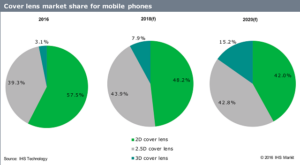The use of 2.5D cover lenses (replacing 2D) in smart devices has been growing since 2014, as a means of differentiation. In 2016 – says IHS in a research note – this glass is becoming mainstream in the smartphone market, as an increasing number of sub-$250 phones are sold with the feature. Most smartwatches are also adopting 2.5D glass.
Demand for 2.5D cover lenses is very low outside of the smartphone and smartwatch markets. 2D will continue to be mainstream, as it is used in TVs, tablets and other applications. IHS predicts that total cover lens shipments will reach 1.9 billion units this year, with revenue of $5.1 billion. Of this market, 2D cover lenses will represent 63.2% of shipments; 2.5D will represent 34.2%; and 3D lenses will have a 2.6% share.
The market for 3D cover lenses is growing in line with the AMOLED market. 3D lens makers are focused on smartphones and smartwatches, so it is unlikely that the market will grow quickly over a short period of time. However, IHS has forecast strong growth from 2017, as phone makers are now shifting from plastic and metal rear cases to glass – particularly 3D glass. This is in order to support the use of NFC, RF and wireless charging.
Unlike 3D front cover lenses, 3D rear cover lenses can be applied to phones with rigid displays; this market is likely to grow faster than the market for front lenses. Most phones using this type of glass are expected to use it on their back, with 2.5D glass on the front.
IHS points out that, if Apple adopts AMOLED for its 2017 iPhone, the market for 3D front cover lenses will grow ‘substantially’. Cover lens makers who cannot produce 3D lenses at this point will struggle to achieve revenue targets, because price competition will be fierce in the 2D and 2.5D markets.
By 2020, IHS expects the shipment share of 2D cover lenses to have fallen rapidly, declining to 48.3% of total shipments, compared to 38.5% for 2.5D and 13.3% for 3D. However, the revenue share of 3D glass will be much higher: 37.1%, compared to 34.5% for 2D glass and 28.4% for 2.5D.
Analyst Comment
2D glass is the traditional flat front glass found on TVs, tablets and many smartphones today. 2.5D glass is becoming more popular on premium phones: it is glass with a slight curvature at the edge, for aesthetic reasons, usually just in one plane.
3D glass is glass with a complete and noticeable curve in more than one plane. The most prominent application it is seen in is the flexible displays on phones like Samsung’s Edge series. It can also be used, as mentioned above, to protect the rear of a phone by curving around the edge. (TA)

